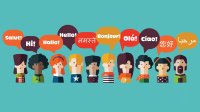English Language Learners
Resources for Teaching English-Language Learners
From literacy instruction to arts and technology integration, explore strategies for engaging English-language learners.
December 5, 2016
Your content has been saved!
Go to My Saved Content.General Tips and Strategies
- Do's & Don'ts for Teaching English-Language Learners: Explore six best practices for working effectively with English-language learners. (Edutopia, Updated 2016)
- Equity for English-Language Learners: Provide equitable accommodations by implementing quality instructional practices and resources: fair assessments, free use of dictionaries and thesauruses, extra time, and the option of multiple media. (Edutopia, 2016)
- Strategies and Resources for Supporting English-Language Learners: Examine faulty assumptions about teaching English-language learners, discover helpful websites, and find articles that discuss good strategies. A classroom tip sheet called "Strategies to Support English-Language Learners" is available for download. (Edutopia, 2015)
- 4 Strategies to Help ELLs in the Mainstream Classroom: Take a look at ELL strategies that work for all students, like reading a book every day, planning multi-modal lessons, shortening lessons, and encouraging writing. (Edutopia, 2015)
- Engaging Parents of English-Language Learners: See how a kindergarten teacher builds community by inviting parents into his classroom. (Edutopia, 2015)
Boosting Student Engagement
- Getting Started With Game-Based Language Learning: Introduce English-language learners to game-based learning to better develop comprehension and communication skills. (Edutopia, 2015)
- Supporting ELLs in PBL Projects: Find out how project-based learning can help teach academic vocabulary, encourage collaboration, scaffold structure and function, allow for assessment and differentiation, and leverage students’ native languages. (Edutopia, 2015)
- How Storytelling Inspires Children to Learn English: Use the power of storytelling to engage English-language learners and help them with their language acquisition. (Edutopia, 2014)
- Using Photos With English-Language Learners: Use activities that incorporate photos to help students integrate and evaluate information in media, develop topics, and use precise language and domain-specific vocabulary. (Edutopia, 2012)
- Using Blogs to Engage English-Language Learners: Read about the benefits of blogging for engaging students. (Edutopia, 2011)
Language and Literacy Instruction
- Common Core Writing and ELLs: Learn about what it means to apply three key elements of the CCSS writing standards—argument, informative/explanatory, and narrative—when teaching English-language learners. (Edutopia, 2016)
- Collaborative Writing, Common Core, and ELLs: Get students to work collaboratively on narratives developing experiences, events, or characters. (Edutopia, 2016)
- Peer Review, Common Core, and ELLs: Use simple peer review activities that are kind, specific, and helpful to assist students in improving their writing and learning about writing. (Edutopia, 2016)
- Teaching Syllables Can Mask Meaningful Morphemes: Help beginning readers grasp the difference between written and spoken language by starting with the meaning of the words rather than their syllabic breakdown. (Edutopia, 2015)
- English-Language Learners and Academic Language: Learn about academic language proficiency, and find some activities that can help teach academic language. (Edutopia, 2014)
- 8 Strategies for Teaching Academic Language: Understand how academic language differs from social language, and discover eight specific strategies for teaching the vocabulary that students require to succeed in the Common Core and on the SAT. (Edutopia, 2014)
Learning English Through the Arts
- The After-School Shakespeare Club: Learn how upper elementary English-language learners created a triumphant reimagining of Shakespeare's Romeo and Juliet. (Edutopia, 2016)
- Makerspaces and Equal Access to Learning: Find out how makerspaces can democratize learning, create a culture of participation, allow for teaching with visual cues, offer thematic planning opportunities, and facilitate differentiated instruction. (Edutopia, 2016)
- Literacy Through Photography for English-Language Learners: Engage ELLs with creating, identifying, and narrating through photographs. Help them learn a language by challenging their thinking in other media. (Edutopia, 2015)
- The Power of Poetry in Primary Classrooms: Use poetry as an effective tool for broadening elementary students' reading choices, strengthening sentence-level skills, teaching ELLs about English, and reinforcing learning across many subjects. (Edutopia, 2015)
Using Technology With ELLs
- 5-Minute Film Festival: 7 Videos for ELL Classrooms: Check out a few of teacher Larry Ferlazzo’s favorite videos. (Edutopia, 2015)
- Blogging for English-Language Learners: Learn about the benefits of student blogging, and find some tips for getting started. (Edutopia, 2015)
- PBL Science Empowered by Discussion Forums: Find better ways to teach science to ELLs through the COPPELLS model of PBL, which provides online and asynchronous forums for reviewing and discussing course material. (Edutopia, 2015)
- Support English-Language Learners With Scannable Technology: Use QR codes and AR triggers to give students a quick, fun way to supplement language acquisition with audio and visual prompts. (Edutopia, 2014)
